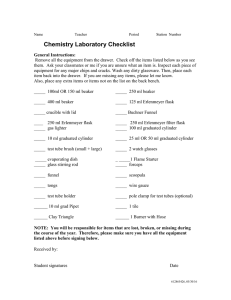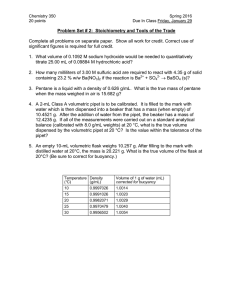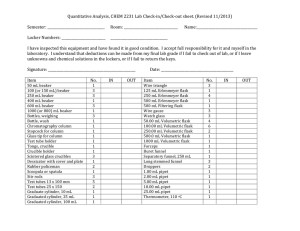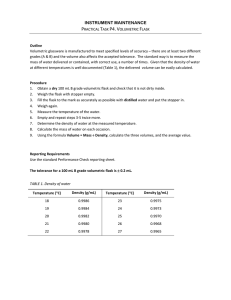Measurements of Mass, Volume and Density
advertisement
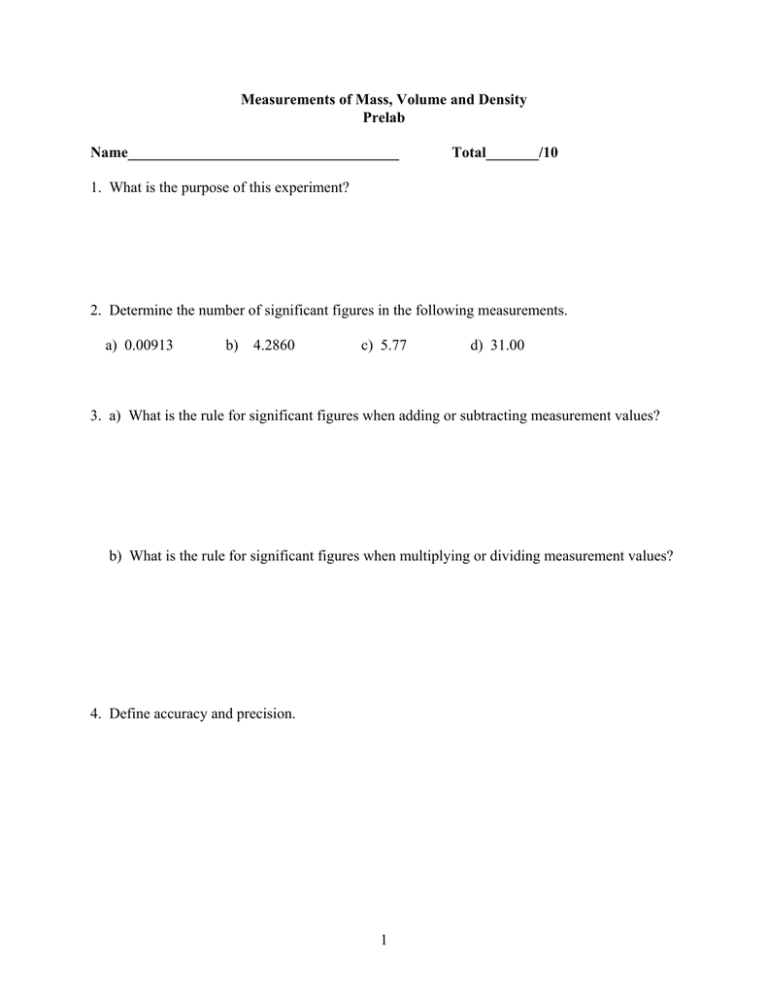
Measurements of Mass, Volume and Density Prelab Name____________________________________ Total_______/10 1. What is the purpose of this experiment? 2. Determine the number of significant figures in the following measurements. a) 0.00913 b) 4.2860 c) 5.77 d) 31.00 3. a) What is the rule for significant figures when adding or subtracting measurement values? b) What is the rule for significant figures when multiplying or dividing measurement values? 4. Define accuracy and precision. 1 Measurements of Mass, Volume and Density In this experiment you will measure the mass of an object with two different kinds of balances and calculate the volume of liquid that is delivered from a transfer pipet. You will also determine the density of an object. Introduction Many experiments require some type of measurement, and are often simple measurements of mass and volume. The validity of an experiment is dependent on the reliability of these measurements. A measurement’s reliability is usually considered in terms of its precision. Precision is the closeness of the agreement between successive measurements of the same quantity. The dispersion in a set of measurements is usually expressed in terms of the standard deviation, whose symbol is s. You are going to be asked to determine the standard deviation for some of your data. The standard deviation measures how close the data are clustered around the mean. The smaller the standard deviation, the more closely the data are clustered around the mean and the more precise your measurements are. After a quantity has been measured in an experiment, it may be necessary to use that measurement in a subsequent calculation. If you use a hand calculator for the arithmetic, eight or more digits may appear in the answer. It is up to you to decide how many of these digits are significant. IT IS YOUR RESPONSIBILITY TO KNOW THE RULES FOR SIGNIFICANT FIGURES BEFORE YOU START THIS EXPERIMENT. You will have to practice using an analytical and top loader balance and then a transfer pipet so you can gain confidence to perform this experiment. Next, you will measure the mass of a flask four times on each balance. The precision of the measurements will be examined when you determine the correct number of significant figures in the mean mass of the flask. You will then add water to the flask from a filled 5-mL pipet, and then measure the mass of the flask and water. You will repeat this process three more times. After calculating the mass of the water that was delivered each time from the pipet, you will calculate the volume of each addition from the mass and density of water. You will then determine the correct number of significant figures in the mean volume. This number will allow you to appreciate the precision that you have achieved with the pipet. You will have to measure volume using a graduated cylinder. A graduated cylinder is used to measure an approximate volume of a liquid. When water or an aqueous solution (a solution containing water) is added, the upper surface of the liquid in the graduated cylinder will be concave. This concave surface is called the meniscus. The bottom of the meniscus is used for all measurements. To avoid error, your eye should always be level with the meniscus when you are measuring the volume. Using the graduated cylinder gives you the ability to measure the volume to only one decimal place. 2 Procedure Part I: Using the Balance 1. Obtain about 100 mL of distilled water in a beaker. Allow the beaker and water to sit on the laboratory bench while you are learning to use the balances and the pipet for parts II and III. The water should come to the temperature of the laboratory during that time. 2. Obtain a thermometer and a 50-mL Erlenmeyer flask with a rubber stopper. 3. Use the SAME top loader balance throughout the experiment. 4. Place the rubber stopper in the Erlenmeyer flask. Tare the top loader balance. Measure and record the combined masses of the flask and stopper. 5. Use tissue paper or paper towel to remove the stoppered flask from the pan of the balance. This is used because some balances are sensitive enough to detect the oils from your fingerprints and you will be weighing the flask on the analytical balance in step 8. 6. Bring your balance to the zero position again. Measure and record the mass of the stoppered flask once again. 7. Repeat steps 5 and 6 until you have measured the mass four times. 8. Calculate the mean (average) mass. The differences between the measured masses and the mean should be very small. If you are unsure of your results, consult your laboratory instructor. 9. Repeat steps 3-8 with the analytical balance. Be sure to use the SAME balance throughout the experiment. Part II: Using the Pipet Be sure to use the SAME BALANCE for ALL measurements. 1. Obtain a 5 mL pipet. 2. Practice using the pipet with distilled water (not the water you have set aside) until you are comfortable with the technique. You should plan on using the same analytical balance and the same pipet throughout the experiment. 3. Using the thermometer, note the temperature of the laboratory and of the distilled water that you have set aside. When the temperatures are identical or very nearly identical, you can begin. Record the temperature to the nearest degree. 4. Measure and record the mass of the empty stoppered flask again using the ANALYTICAL BALANCE. Use tissue paper/paper towel as you did before. 3 5. Remove the flask from the balance, using tissue paper. Pipet exactly 5 mL of the room-temperature water into the flask without touching the flask with your fingers. Using tissue paper/paper towel, replace the stopper to prevent evaporation. 6. Bring your balance to the zero position. Measure and record the combined mass of the water and the stoppered flask. 7. Remove the flask from the balance. Do not pour out the first sample. Pipet another 5 mL sample into the flask. The volume of the water in the flask should now be 10 mL. Replace the stopper and repeat step 6. 8. Repeat until four samples of water have been delivered to the flask and the final volume is 20 mL. 9. Calculate the mass of water that was delivered each time from your pipet. These masses should be approximately identical. 10. Calculate the volume of each sample from the mass and density of water. Use Table 1 to find the density that corresponds to your recorded temperature. Part III: Determining the Density of an Object 1. Using your graduated cylinder, measure 40-50 mL of water from your beaker in Part I and leave it in the graduated cylinder. Record this measurement to the nearest 0.1 mL. 2. Take one of the objects from the samples that are given and find its mass on the analytical balance. 3. Place that same object in the graduated cylinder with the water in it. Make sure that the object is completely submerged in the water. If the object is not completely submerged, repeat steps 1and 2 being sure to dry the object and adding more water in the graduated cylinder. Avoid splashing any water out of the graduated cylinder or cracking the bottom of the graduated cylinder. 4. Record the level of the water with object in the graduated cylinder. The difference between this measurement and the measurement in step 1 is the volume of the object. 5. Using the same object that has been dried well, measure the length, width and height of the object to the nearest 0.01 cm. 6. Calculate the volume of the object using the measurements determined in step 5. 7. Calculate the density of the object (g/mL and g/cm3) using the correct number of significant figures. 4 Table 1 Density (g/mL) of Water at Various Temperatures (o C) Temp. Density Temp. Density Temp. 17 18 19 20 21 0.9988 0.9986 0.9984 0.9982 0.9980 22 23 24 25 26 0.9978 0.9976 0.9973 0.9971 0.9968 27 28 29 30 31 Density 0.9965 0.9962 0.9959 0.9956 0.9953 Example I: How to Calculate a Standard Deviation You obtain the following measurements: 15.2654, 15.2657, 15.2658 and 15.2655. In the following calculations, each individual measurement from above will be represented using the symbol xi and the mean (the average of these values) will be given the symbol x . s= ∑d 2 i N −1 Σ means “the sum of” di = xi - x N = the number of measurements x = 15.2656 xi 15.2654 15.2657 15.2658 15.2655 s= di2 di (xi – x ) -0.0002 0.0001 0.0002 -0.0001 0.00000004 0.00000001 0.00000004 0.00000001 0.00000010 = Σ di2 0.00000010 = 0.000183 = 0.0002 4 −1 When you report a value, it is the mean (average) value that is reported along with the standard deviation to show the precision of the measurements which contributed to the mean value. Therefore, the value reported for this example would be 15.2656 ± 0.0002. 5 Results Part I Using the Analytical Balance Mass of the stoppered flask (g) ____________ ____________ ____________ ____________ Mean mass (g) ____________ Calculation: Using the Top Loader Balance Mass of the stoppered flask (g) ____________ ____________ ____________ ____________ Mean mass (g) ____________ Part II Using the Pipet Temperature (o C) __________ Density of water (g/mL) __________ Addition No. Mass after addition (g) 1 2 3 __________ __________ __________ __________ Mass before addition (g) __________ __________ __________ __________ Mass of water in flask (g) __________ __________ __________ __________ Volume of water delivered each time (mL) __________ __________ __________ __________ Mean volume (mL) __________ 6 4 Calculations (Part II): Part III Determining the Density of an Object Mass of the object (g) __________ Volume after adding object (mL) __________ Volume before adding object (mL) __________ Volume of object (mL) __________ Volume of object (cm3) __________ (using the equation V = hπr2 ) Diameter of object (cm) ____________ Radius of object (cm) __________ Height of object (cm) __________ Density of the object (g/mL) __________ Density of the object (g/cm3) ____________ Calculations: 7 Questions 1 a. Calculate the standard deviation (look at example on page 5) for the measured mass of the empty stoppered flask. (Pick the values where there is a greater difference between the measurements.) b. Based on your standard deviation from part a, report the mean value for the average mass of the flask and give the precision of this value. (Ex. Your mean value is 10.12, and your standard deviation is 3.0 x 10-2. You would report your mean mass as 10.12 ± 0.03.) 8
